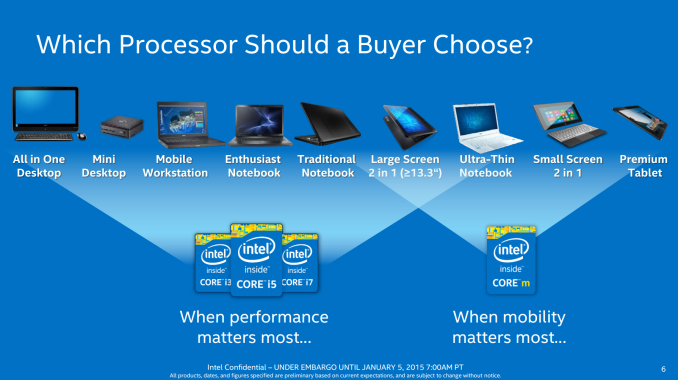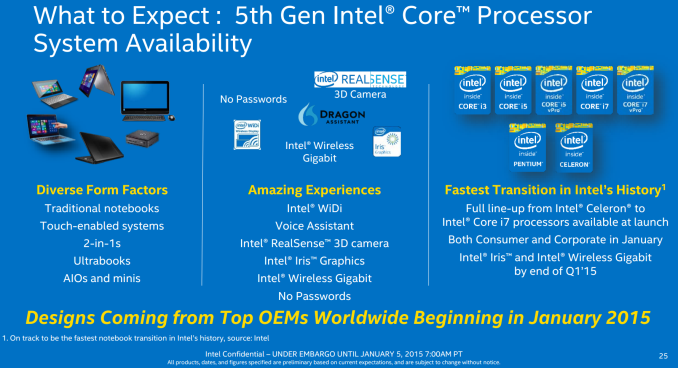Intel Releases Broadwell-U: New SKUs, up to 48 EUs and Iris 6100
by Ian Cutress on January 5, 2015 10:00 AM ESTFitting in With Core M
The staggered release of Broadwell is nothing new. Previous releases from Intel has seen them pick a particular market and aim at that first, whether it be tablet, mobile devices, ultrabooks or desktops, with the rest to follow. Core M, Intel’s 4.5 W ‘Broadwell-Y’ part, has been in the market for over a month with designs such as the Lenovo Yoga 3 Pro, although the number of SKUs available as well as worldwide distribution has been relatively slow, with the designs featuring Core M being expensive in terms of casual computing and more premium upgrades. Broadwell-U changes this by opening up the power envelope, and as such Intel sees the market at follows:
The Broadwell-U processors from Intel are aiming to give enough performance from AIO desktop systems to mini desktops, premium mobile applications all through to large 2-in-1s. There is some overlap with Core M, particularly with the 7.5W cTDP down elements of the range, but the interesting element will be pricing. The Celerons come in around $100, with the Pentium at $160, but then it gets expensive for Broadwell-U. $275 to $315 covers all the i3 and i5 parts both at 15W and 28W, ending with $393/$426 for the i7 parts. Further to my efficiency comments above, on paper at least the i5-5350U or i5-5250U would seem the most interesting processors of the bunch.
Release Dates
In our conference call with Intel, it was clear that these CPUs are shipping to their partners today. Throughout CES there will be a number of manufacturers announcing their products, and as per the norm Intel allows the partners to introduce their own products, rather than showing examples of where Broadwell-U fits in. However, because Broadwell-U is designed to be pin-compatible with Haswell-U, we might see some manufacturers purely re-releasing some of their designs with the newer CPU and a firmware update. Nevertheless, Intel is expecting OEM systems with Broadwell-U to start shipping in North America within the month. Designs with Iris graphics, or those featuring Intel based WiGig connectivity, will be more towards the end of Q1. Overall Intel is tracking ‘hundreds of designs’ involving Broadwell, indicating that it will be a significant push to bring 14nm to the market.












85 Comments
View All Comments
KaarlisK - Monday, January 5, 2015 - link
"It might come across as somewhat surprising that a 15W CPU like the i7-5650U has a 2.2 GHz base frequency but then a 3.2 GHz to 3.1 GHz operating window, and yet the i7-5557U has a 3.1 GHz base with 3.4 GHz operating for almost double the TDP. Apart from the slight increase in CPU and GPU frequency, it is hard to account for such a jump without point at the i7-5650U and saying that ultimately it is the more efficient bin of the CPUs."This is not surprising. This is used to increase the GPU performance. 28W CPUs have Iris 6100, 15W CPUs have HD 6000.
In no way does TDP tell us anything about efficiency.
aratosm - Monday, January 5, 2015 - link
Iris 6100 vs HD 6000 are almost identical. The only difference is a slightly faster clock speed. I think the problem is, HD6000 will throttle more to stay in that power envelope.Topinio - Monday, January 5, 2015 - link
Looks to me like the 23W ones (i.e. those with the 6100 graphics) will be the only ones to be capable of being near the max turbo clocks for long.Would also be interesting to know the AVX base and turbo clocks for these chips, to compare the possible 64b DP GFLOPS from the CPU cores to those listed on page 2 from the GPUs. Top bin is likely somewhere < 102 (vs 211 from GPU), but how much lower?
MrSpadge - Monday, January 5, 2015 - link
For the big Xeons the AVX base clock is typically 200 MHz below the regular base clock. They operate in a similar frequency & voltage range as the mobile chips (and are as power-limited as they are), so expect the same to apply here.hansmuff - Thursday, January 8, 2015 - link
First time I read about AVX clocks, then found another mention in a previous Xeon CPU article. Is this a thing for Xeon only, or do the Haswell desktop chips throttle the clock with heavy AVX as well?naloj - Monday, January 5, 2015 - link
A good example of this is in the throttling of the HD5000 in the 15W NUC i5-4250. You can get 40% better performance by changing the TDP settings from 25W short burst / 15W steady to 35W short burst / 31W steady.MrSpadge - Monday, January 5, 2015 - link
"In no way does TDP tell us anything about efficiency."Agreed - TDP is far to crude for this. Intel Desktop CPUs often operate far below TDP, whereas mobile chips are throttled by it. How much? Depends on the laptop, environment temperature etc.
So even though the 15 W CPUs quoted above are allowed to top out at 3+ GHz, they won't run at anywhere close to this frequency under sustained heavy load. The 28 W chips should have no trouble sustaining the speed, given adequate cooling.
zepi - Monday, January 5, 2015 - link
Iris 6100 + edram or at least DDR4 bandwidth increases would have made a terrific difference to "retina" and high-dpi ultrabooks / laptops, but now this upgrade is watered to irrelevancy.Nothing to see here...
HungryTurkey - Wednesday, January 14, 2015 - link
In a retina/hdpi environment, few applications would come close to saturating the bus. The EUs (even with the 6100) would bottleneck long before LPDDR3/DDR3 would.fokka - Thursday, January 8, 2015 - link
as i see it the given tdp only ensures operation at base clocks and without a substantial graphics load. operation at turbo clocks requires to overstep the tdp until power draw and or temps are too high and the clock returns to the base frequency.if you look at it like this it's not surprising a 15w sku has a base clock of 2.2ghz ans a 28w sku 3.1ghz. that said the 28w tdp still looks "too high" for the frequency you get out of it, but i guess that this extra power/heat-budget is there for the sole reason so the 28w sku can operate at turbo clocks for longer without throttling down again, plus there is more headroom for a graphics load at the same time. this ensures, even with similar hardware and turbo-clocks, the 28w sku is allowed to produce more heat and in turn get more work done in the same time.
that's the same reason core-m has very high turbo speeds, but can only turbo for a couple seconds until it's too hot and it "throttles" down to base clocks.